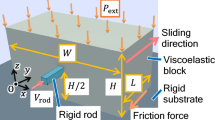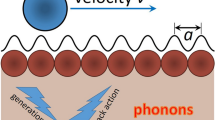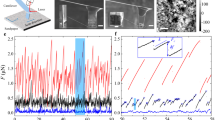Abstract
Consider a block placed on a table and pushed sideways until it begins to slide. Amontons and Coulomb found that the force required to initiate sliding is proportional to the weight of the block (the constant of proportionality being the static coefficient of friction), but independent of the area of contact1. This is commonly explained by asserting that, owing to the presence of asperities on the two surfaces, the actual area in physical contact is much smaller than it seems, and grows in proportion to the applied compressive force1. Here we present an alternative picture of the static friction coefficient, which starts with an atomic description of surfaces in contact and then employs a multiscale analysis technique to describe how sliding occurs for large objects. We demonstrate the existence of self-healing cracks2,3,4 that have been postulated to solve geophysical paradoxes about heat generated by earthquakes5,6,7,8,9,10,11,25,26,27, and we show that, when such cracks are present at the atomic scale, they result in solids that slip in accord with Coulomb's law of friction. We expect that this mechanism for friction will be found to operate at many length scales, and that our approach for connecting atomic and continuum descriptions will enable more realistic first-principles calculations of friction coefficients.
This is a preview of subscription content, access via your institution
Access options
Subscribe to this journal
Receive 51 print issues and online access
$199.00 per year
only $3.90 per issue
Buy this article
- Purchase on Springer Link
- Instant access to full article PDF
Prices may be subject to local taxes which are calculated during checkout


Similar content being viewed by others
References
Persson, B. N. J. Sliding Friction: Physical Principles and Applications (Springer, Heidelberg, 1998).
Comninou, M. & Dundurs, J. Can solids slide without slipping? Int. J. Solids Struct. 14, 251–260 (1978).
Weertman, J. Unstable slippage across a fault that separates elastic media of different elastic constants. J. Geophys. Res. B 85, 1455–1461 (1980).
Caroli, C. Slip pulses at a sheared frictional viscoelastic/nondeformable interface. Phys. Rev. E 62, 1729–1735 (2000).
Brune, J. N., Brown, S. & Johnson, P. A. Rupture mechanism and interface separation in foam rubber models of earthquakes: a possible solution to the heat flow paradox and the paradox of large overthrust. Tectonophysics 218, 59–67 (1993).
Brown, S. R. Frictional heating on faults: Stable sliding versus stick slip. J. Geophys. Res. 103, 7413–7420 (1998).
Anooshehpoor, A. & Brune, J. N. Wrinkle-like Weertman pulse at the interface between two blocks of foam rubber with different velocities. Geophys. Res. Lett. 26, 2025–2028 (1999).
Scott, R. S. Seismicity and stress rotation in a granular model of the brittle crust. Nature 381, 5922–595 (1996).
Ben-Zion, Y. & Andrews, D. J. Properties and implications of dynamic rupture along a material interface. Bull. Seismol. Soc. Am. 88, 1085–1094 (1998).
Mora, P. The weakness of earthquake faults. Geophys. Res. Lett. 26, 123–126 (1999).
Place, D. & Mora, P. The lattice solid model to simulate the physics of rocks and earthquakes: incorporation of friction. J. Comput. Phys. 150, 332–372 (1999).
Freund, L. B. Dynamic Fracture Mechanics (Cambridge Univ. Press, Cambridge, 1990).
Dhaliwal, R. J. & Saxena, H. S. Moving Griffith crack at the interface of two orthotropic elastic layers. J. Math. Phys. Sci. 26, 237–254 (1992).
Das, S. & Patra, B. Moving Griffith crack at the interface of two dissimilar orthotropic half planes. Eng. Fract. Mech. 54, 523–531 (1996).
Ranjith, K. & Rice, J. R. Slip dynamics at an interface between dissimilar materials. J. Mech. Phys. Solids 49, 341–361 (2001).
Cochard, A. & Rice, J. R. Fault rupture between dissimilar materials: III-posedness, regularization, and slip-pulse response. J. Geophys. Res. B 105, 25891–25907 (2001).
Slepyan, L. I. Plane problem of a crack in a lattice. Izv. Akad. Nauk SSSR Mekh. Tverd. Tela 16, 101–115 (1982).
Marder, M. & Gross, S. Origin of crack tip instabilities. J. Mech. Phys. Solids 43, 1–48 (1995).
Wilson, G. T. The factorization of matrixial spectral densities. SIAM J. Appl. Math. 23, 420–426 (1972).
Eggermont, P. & Lubich, C. Fast numerical solution of singular integral equations. J. Integral Equations Appl. 6, 335–351 (1994).
Williams, M. L. The stresses around a fault or crack in dissimilar media. Bull. Seismol. Soc. Am. 49, 199–204 (1959).
Deng, X. Complete complex series expansions of near-tip fields for steadily growing interface cracks in dissimilar isotropic materials. Eng. Fract. Mech. 42, 237–242 (1992).
Holland, D. & Marder, M. Cracks and atoms. Adv. Mater. 11, 793–806 (1999).
Müser, M. H., Wenning, L. & Robbins, M. O. Simple microscopic theory of Amontons's laws for static friction. Phys. Rev. Lett. 86, 1295–1298 (2001).
Heaton, T. H. Evidence for and implications of self-healing pulses of slip in earthquake rupture. Phys. Earth Planet. Interiors 64, 1–20 (1990).
Adams, G. G. Dyanmic motion of two elastic half-spaces in relative sliding without slipping. J. Tribol. 121, 455–461 (1999).
Ranjith, K. & Rice, J. R. Slip dynamics at an interface between dissimilar materials. J. Mech. Phys. Solids 49, 341–361 (2001).
Acknowledgements
We thank H. Swinney for suggestions on presentation. This work was supported by the NSF and by a fellowship from TICAM at The University of Texas at Austin.
Author information
Authors and Affiliations
Corresponding author
Rights and permissions
About this article
Cite this article
Gerde, E., Marder, M. Friction and fracture. Nature 413, 285–288 (2001). https://doi.org/10.1038/35095018
Received:
Accepted:
Issue Date:
DOI: https://doi.org/10.1038/35095018
This article is cited by
-
Relation between force chain quantitative characteristics and side wall friction behaviour during ferrous powder compaction
Granular Matter (2022)
-
Statistical mechanics of rate-independent stick-slip on a corrugated surface composed of parabolic wells
Continuum Mechanics and Thermodynamics (2022)
-
The structure of slip-pulses and supershear ruptures driving slip in bimaterial friction
Nature Communications (2016)
-
Sliding Without Slipping Under Coulomb Friction: Opening Waves and Inversion of Frictional Force
Tribology Letters (2016)
-
Recent developments in dynamic fracture: some perspectives
International Journal of Fracture (2015)
Comments
By submitting a comment you agree to abide by our Terms and Community Guidelines. If you find something abusive or that does not comply with our terms or guidelines please flag it as inappropriate.



